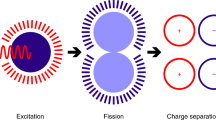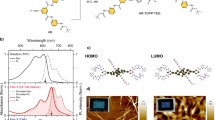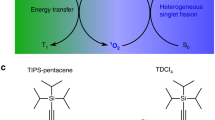Abstract
Singlet exciton fission, the spin-conserving process that produces two triplet excited states from one photoexcited singlet state, is a means to circumvent the Shockley–Queisser limit in single-junction solar cells. Although the process through which singlet fission occurs is not well characterized, some local order is thought to be necessary for intermolecular coupling. Here, we report a triplet yield of 200% and triplet formation rates approaching the diffusion limit in solutions of bis(triisopropylsilylethynyl (TIPS)) pentacene. We observe a transient bound excimer intermediate, formed by the collision of one photoexcited and one ground-state TIPS-pentacene molecule. The intermediate breaks up when the two triplets separate to each TIPS-pentacene molecule. This efficient system is a model for future singlet-fission materials and for disordered device components that produce cascades of excited states from sunlight.
This is a preview of subscription content, access via your institution
Access options
Subscribe to this journal
Receive 12 print issues and online access
$259.00 per year
only $21.58 per issue
Buy this article
- Purchase on Springer Link
- Instant access to full article PDF
Prices may be subject to local taxes which are calculated during checkout






Similar content being viewed by others
Change history
21 November 2013
In the version of this Article originally published, the colour scales on Figs 2 and 4 were incorrect. These have now been corrected in the online versions of the Article.
References
Singh, S., Jones, W. J., Siebrand, W., Stoicheff, B. P. & Schneider, W. G. Laser generation of excitons and fluorescence in anthracene crystals. J. Chem. Phys. 42, 330–342 (1965).
Swenberg, C. E. & Tracy, W. T. Bimolecular radiationless transitions in crystalline tetracene. Chem. Phys. Lett. 2, 327–328 (1968).
Geacintov, N., Pope, M. & Vogel, F. Effect of magnetic field on the fluorescence of tetracene crystals: exciton fission. Phys. Rev. Lett. 22, 593–596 (1969).
Smith, M. B. & Michl, J. Singlet fission. Chem. Rev. 110, 6891–6936 (2010).
Smith, M. B. & Michl, J. Recent advances in singlet fission. Annual review of Physical Chemistry 64, 361–386 (2013).
Merrifield, R. E. Diffusion and mutual annihilation of triplet excitons in organic crystals. Acc. Chem. Res. 1, 129–135 (1968).
Merrifield, R. E., Avakian, P. & Groff, R. P. Fission of singlet excitons into pairs of triplet excitons in tetracene crystals. Chem. Phys. Lett. 3, 155–157 (1969).
Chan, W., Ligges, M. & Zhu, X-Y. The energy barrier in singlet fission can be overcome through coherent coupling and entropic gain. Nature Chem. 4, 840–845 (2012).
Jundt, C. et al. Exciton dynamics in pentacene thin films studied by pump–probe spectroscopy. Chem. Phys. Lett. 241, 84–88 (1995).
Vilar, M. R., Heyman, M. & Schott, M. Spectroscopy of low-energy electrons backscattered from an organic solid surface: pentacene. Chem. Phys. Lett. 94, 522–526 (1983).
Shockley, W. & Queisser, H. J. Detailed balance limit of efficiency of p–n junction solar cells. J. Appl. Phys. 32, 510–519 (1961).
Hanna, M. C. & Nozik, A. J. Solar conversion efficiency of photovoltaic and photoelectrolysis cells with carrier multiplication absorbers. J. Appl. Phys. 100, 074510 (2006).
Jadhav, P. J. et al. Triplet exciton dissociation in singlet exciton fission photovoltaics. Adv. Mater. 24, 6169–6174 (2012).
Ehrler, B., Wilson, M. W. B., Rao, A., Friend, R. H. & Greenham, N. C. Singlet exciton fission-sensitized infrared quantum dot solar cells. Nano Lett. 12, 1053–1057 (2012).
Paci, I. et al. Singlet fission for dye-sensitized solar cells: can a suitable sensitizer be found? J. Am. Chem. Soc. 128, 16546–16553 (2006).
Zimmerman, P. M., Zhang, Z. & Musgrave, C. B. Singlet fission in pentacene through multi-exciton quantum states. Nature Chem. 2, 648–652 (2010).
Zimmerman, P. M., Bell, F., Casanova, D. & Head-Gordon, M. Mechanism for singlet fission in pentacene and tetracene: from single exciton to two triplets. J. Am. Chem. Soc. 133, 19944–19952 (2011).
Greyson, E. C., Vura-Weis, J., Michl, J. & Ratner, M. A. Maximizing singlet fission in organic dimers: theoretical investigation of triplet yield in the regime of localized excitation and fast coherent electron transfer. J. Phys. Chem. B 114, 14168–14177 (2010).
Chan, W-L. et al. Observing the multiexciton state in singlet fission and ensuing ultrafast multielectron transfer. Science 334, 1541–1545 (2011).
Zimmerman, P. M., Musgrave, C. B. & Head-Gordon, M. A correlated electron view of singlet fission. Acc. Chem. Res. 46, 1339–1347 (2013).
Beljonne, D., Yamagata, H., Brédas, J. L., Spano, F. C. & Olivier, Y. Charge-transfer excitations steer the Davydov splitting and mediate singlet exciton fission in pentacene. Phys. Rev. Lett. 110, 226402 (2013).
Roberts, S. T. et al. Efficient singlet fission discovered in a disordered acene film. J. Am. Chem. Soc. 134, 6388–6400 (2012).
Burdett, J. J., Müller, A. M., Gosztola, D. & Bardeen, C. J. Excited state dynamics in solid and monomeric tetracene: the roles of superradiance and exciton fission. J. Chem. Phys. 133, 144506 (2010).
Burdett, J. J., Gosztola, D. & Bardeen, C. J. The dependence of singlet exciton relaxation on excitation density and temperature in polycrystalline tetracene thin films: kinetic evidence for a dark intermediate state and implications for singlet fission. J. Chem. Phys. 135, 214508 (2011).
Sheraw, C. D., Jackson, T. N., Eaton, D. L. & Anthony, J. E. Functionalized pentacene active layer organic thin-film transistors. Adv. Mater. 15, 2009–2011 (2003).
Giri, G. et al. Tuning charge transport in solution-sheared organic semiconductors using lattice strain. Nature 480, 504–508 (2011).
Gundlach, D. J. et al. Contact-induced crystallinity for high-performance soluble acene-based transistors and circuits. Nature Mater. 7, 216–221 (2008).
Wilson, M. W. B. et al. Ultrafast dynamics of exciton fission in polycrystalline pentacene. J. Am. Chem. Soc. 133, 11830–11833 (2011).
Ramanan, C., Smeigh, A. L., Anthony, J. E., Marks, T. J. & Wasielewski, M. R. Competition between singlet fission and charge separation in solution-processed blend films of 6,13-bis(triisopropylsilylethynyl)pentacene with sterically-encumbered perylene-3,4:9,10-bis(dicarboximide)s. J. Am. Chem. Soc. 134, 386–397 (2012).
Van Hal, P. A. et al. Photoinduced singlet and triplet energy transfer in fullerene–oligothiophene–fullerene triads. Synthetic Met. 116, 123–127 (2001).
Berg, O. G. & von Hippel, P. H. Diffusion-controlled macromolecular interactions. Ann. Rev. Biophys. Biophys. Chem. 14, 131–160 (1985).
Ehrler, B. et al. In situ measurement of exciton energy in hybrid singlet-fission solar cells. Nature Commun. 3, 1019 (2012).
Dreuw, A., Weisman, J. L. & Head-Gordon, M. Long-range charge-transfer excited states in time-dependent density functional theory require non-local exchange. J. Chem. Phys. 119, 2943 (2003).
Mannsfeld, S. C. B., Tang, M. L. & Bao, Z. Thin film structure of triisopropylsilylethynyl-functionalized pentacene and tetraceno[2,3-b]thiophene from grazing incidence X-ray diffraction. Adv. Mater. 23, 127–131 (2011).
Johnson, J. C., Nozik, A. J. & Michl, J. The role of chromophore coupling in singlet fission. Acc. Chem. Res. 46, 1290–1299 (2013).
Renaud, N., Sherratt, P. A. & Ratner, M. A. Mapping the relation between stacking geometries and singlet fission yield in a class of organic crystals. J. Phys. Chem. Lett. 4, 1065–1069 (2013).
Rao, A. et al. Exciton fission and charge generation via triplet excitons in pentacene/C60 bilayers. J. Am. Chem. Soc. 132, 12698–12703 (2010).
Müller, A. M., Avlasevich, Y. S., Müllen, K. & Bardeen, C. J. Evidence for exciton fission and fusion in a covalently linked tetracene dimer. Chem. Phys. Lett. 421, 518–522 (2006).
Müller, A. M., Avlasevich, Y. S., Schoeller, W. W., Müllen, K. & Bardeen, C. J. Exciton fission and fusion in bis(tetracene) molecules with different covalent linker structures. J. Am. Chem. Soc. 129, 14240–14250 (2007).
Wang, C. & Tauber, M. J. High-yield singlet fission in a zeaxanthin aggregate observed by picosecond resonance Raman spectroscopy. J. Am. Chem. Soc. 132, 13988–13991 (2010).
Schulten, K., Ohmine, I. & Karplus, M. Correlation effects in the spectra of polyenes. J. Chem. Phys. 64, 4422–4441 (1976).
Gradinaru, C. C. et al. An unusual pathway of excitation energy deactivation in carotenoids: singlet-to-triplet conversion on an ultrafast timescale in a photosynthetic antenna. Proc. Natl Acad. Sci. USA 98, 2364–2369 (2001).
Barford, W. Electronic and Optical Properties of Conjugated Polymers (Oxford Univ. Press, 2005).
Berkelbach, T. C., Hybertsen, M. S. & Reichman, D. R. Microscopic theory of singlet exciton fission. I. General formulation. J. Chem. Phys. 138, 114102 (2013).
Ito, S., Minami, T. & Nakano, M. Diradical character based design for singlet fission of condensed- ring systems with 4nπ electrons. J. Phys. Chem. C 116, 19729–19736 (2012).
Chan, W-L., Tritsch, J. R. & Zhu, X-Y. Harvesting singlet fission for solar energy conversion: one- versus two-electron transfer from the quantum mechanical superposition. J. Am. Chem. Soc. 134, 18295–18302 (2012).
Azarova, N. A. et al. Fabrication of organic thin-film transistors by spray-deposition for low-cost, large-area electronics. Org. Electron 11, 1960–1965 (2010).
Acknowledgements
B.J.W. was supported by a Herchel Smith Research Fellowship. A.J.M. received funding from a Marie Curie Scholarship. D.B. is a FNRS Research Director. Both A.J.M and D.B. acknowledge support from the European Community's Initial Training Network SUPERIOR (PITN-GA-2009-238177). Further funding for this project came from the Engineering and Physical Sciences Research Council and a pump-prime grant from the Winton Programme for the Physics of Sustainability. We thank A. Rao, K. Johnson and S. Gélinas for general discussion, and D. Howe for assistance with diffusion-ordered NMR spectroscopy.
Author information
Authors and Affiliations
Contributions
B.J.W. conceived the project, B.J.W. and A.J.M. planned and carried out the experiments, A.J.M. performed the calculations, B.J.W., A.J.M., D.B. and R.H.F. discussed the experiments and results, and B.J.W., A.J.M. and R.H.F. wrote the manuscript.
Corresponding author
Ethics declarations
Competing interests
The authors declare no competing financial interests.
Supplementary information
Supplementary information
Supplementary information (PDF 2039 kb)
Rights and permissions
About this article
Cite this article
Walker, B., Musser, A., Beljonne, D. et al. Singlet exciton fission in solution. Nature Chem 5, 1019–1024 (2013). https://doi.org/10.1038/nchem.1801
Received:
Accepted:
Published:
Issue Date:
DOI: https://doi.org/10.1038/nchem.1801
This article is cited by
-
Singlet fission initiating organic photosensitizations
Scientific Reports (2024)
-
Singlet fission dynamics modulated by molecular configuration in covalently linked pyrene dimers, Anti- and Syn-1,2-di(pyrenyl)benzene
Communications Chemistry (2023)
-
Extracting quantitative dielectric properties from pump-probe spectroscopy
Nature Communications (2022)
-
Singlet fission initiating triplet generations of BODIPY derivatives through \(\pi \)-stacking: a theoretical study
Scientific Reports (2022)
-
Reply to: On the observation of photo-excitation effects in molecules using muon spin spectroscopy
Nature Materials (2022)



